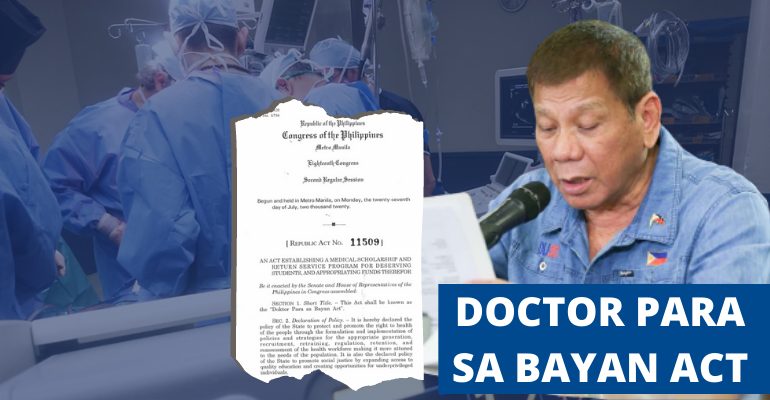President Duterte signed the “Doktor Para sa Bayan Act” on December 23 to provide medical scholarships to deserving students.
The Republic Act (RA) No. 11509 or the “Doktor Para sa Bayan Act” aims to establish a medical scholarship and return service program to help deserving students pursue medical education and training and enable them to serve government public health offices or hospitals in their hometown or any underserved town.
“Doktor Para sa Bayan Act” will be established in state universities and colleges or private partner higher education institutions in regions with no SUCs. Moreover, qualified applicants from municipalities with no government physicians will be prioritized in allocating scholarship slots to ensure that there is at least one doctor for every town in the country.
You Might Also Want To Read: DOH Medical Scholarship: A Scholarship Guide
The law mandates the acceptance of at least one scholar from each municipality of the country. But if no one is qualified in a certain municipality, other applicants will be considered.
Scholar Benefits
Qualified students will be entitled to the following benefits:
- free tuition and other school fees;
- allowance for prescribed books, supplies, and equipment;
- clothing or uniform allowance, dormitory or boarding house accommodation allowance;
- transportation allowance;
- internship fees, medical board review fees;
- licensure fees;
- annual medical insurance; and
- other education-related miscellaneous subsistence or living allowances.
Qualifications
To be qualified, a student must be/have:
- a Filipino citizen living in the Philippines
- a graduating student or a graduate of an appropriate undergraduate program identified as a prerequisite for a medicine degree from any higher educational institution recognized by the Commission on Higher Education (CHED)
- passed the entrance examinations and complied with other requirements for admission into a medicine degree
- obtained a National Medical Admission test score mandated by CHED and required by the educational institution where the student intends to enroll in.
Meanwhile, a student will lose the scholarship if he/she:
- accepts another scholarship from other government or private entity
- fails to meet the academic requirements or to complete the course within the period prescribed by the school he is enrolled in without valid cause
- fails to obtain a passing grade in the physician licensure examination within five years from the time he has completed the mandatory internship program
- commits gross misconduct
After passing the physician licensure examination and the conferment of the license to practice, the scholar will become part of the public health and medical service system. The scholar will be required to:
- serve in a government public health office, government hospital, or any accredited government health facility in his hometown or in any underserved municipality closest to his hometown for at least one year for every scholarship year availed of;
- render the mandatory return service within six years from the time of passing the licensure examination for those who have availed of a four-year program and seven years for those who have availed of a five-year program;
In times of pandemic or public health emergency, the health department may require the scholars to serve in any public health office or a government hospital where their services may be needed.
A physician who has availed of the program but fails or refuses to comply with the mandatory return service and integration will be required to pay two times the full cost of the scholarship. If a physician does not pay the costs, his license would not be renewed, but the provision does not apply to those who failed to comply with the required return service because of a serious illness.
Around 6 out of 10 Filipinos die without seeing a doctor
Sen. Joel Villanueva, the sponsor of RA 11509 that was principally authored by Senate President Vicente Sotto III, said most of the country’s doctors are concentrated in urban centers like the National Capital Region where nearly 40 percent of the licensed physicians practice their profession.
In contrast, Region 4B (Mimaropa), Region 12 (Caraga), and the Bangsamoro Autonomous Region in Muslim Mindanao have one doctor per 10,000 population.
For the Philippines to meet the World Health Organization-prescribed ratio of 10 doctors per 10,000 population, the country needs to produce over 80,000 doctors.
Citing data from the Philippine Statistics Authority, Villanueva said some six out of 10 Filipinos die without seeing a doctor for treatment in the country.
See full document here.
~
Duterte also signed three other laws on the same date, including a law that will set up an alternative learning system for adults and out-of-school children, make a certification for organic produce more affordable, and allow the Chief Executive to fast-track the processing of key documents during a national emergency.
(Source: onenews.ph)

Leave a Reply